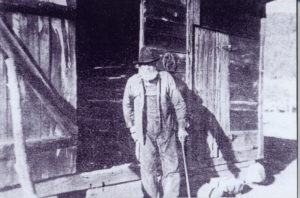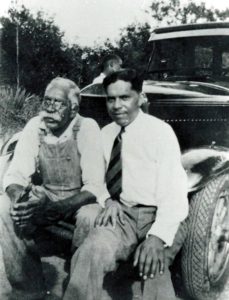by Katherine C. Cutshall
In February, we take especially take the opportunity to acknowledge the contributions of Black Americans and celebrate the month as Black History Month. African-American people have made an important impact on the history and culture of the Swannanoa Valley and western North Carolina as a whole. From their earliest documented arrival in the Valley in the late 18th century as enslaved people, all the way to the present day as politicians and civic leaders, they have shown courage, perseverance, patriotism, and made numerous sacrifices to contribute to the cultural, economic and social development of the region.
Poet Frank X. Walker coined the term Affrilachia to describe the unique cultural heritage of Black Highlanders; the Stepp family, who made their home in Black Mountain, especially represents the exceptional history of African Americans in western North Carolina and the Appalachian region. Their family history in the Swannanoa Valley is anchored on stagecoach inns, the coming of the railroad, and the story of African-American education in the Jim Crow South. Their history in the Swannanoa Valley is traced through their family matriarch, Myra.

Myra, like the majority of blacks living in western North Carolina in the 19th century was enslaved, and according to family history was part Cherokee and born in Murphy, North Carolina. Myra was owned by prominent Buncombe County Slave Owner Joseph Stepp who was also the father of her children. According to the 1850 Slave schedules, a separate census for enslaved people, Joe Stepp owned seven slaves. His father William who lived close by owned another eight. Myra, who was recorded as 19 years old on the 1850 schedules, like many other enslaved women in western North Carolina would have been tasked with picking crops, carding and spinning wool, and other domestic tasks. According to her family history, Myra loved to cook. When each child reached a particular age, she would cook them their own cake.
Myra’s tasks were carried out on a large farm that eventually grew into one of the first hotels in eastern Buncombe County, the Black Mountain Hotel. Unlike many enslaved people in the lower south Myra and her children born into slavery did not work on a large plantation cultivating cotton, rice, or tobacco. Stepp slaves spent a great deal of time attending to travelers or “summer people” from these regions. The “summer people” traveled to western North Carolina to escape the hot, humid climate and diseases brought on by mosquitoes like malaria and yellow fever in the lower south. It is said that Myra’s children, because of their favor in the eyes of Joseph Stepp, their father and master, were allowed to take hotel guests on horse and buggy sightseeing tours around Black Mountain and often worked in the “Big house.” The skills they learned on the Stepp Hotel property were diverse; Myra’s children went on to become carpenters, contractors, brick masons, railroad workers and important community leaders well into the 20th century.
As Joseph Stepp approached death, he offered the children born of his relationships with Myra and another enslaved woman the opportunity to purchase land at $1.00 per acre. Later, they made a return on those investments by selling the land. Her daughter Martha donated part of her land to help establish one of the first African-American churches and cemeteries in eastern Buncombe County, Thomas Chapel A.M.E Church and Oak Grove Cemetery which is as of 2009 protected on the National Register of Historic Places.
Myra’s sons Ed and John Myra went on to become important community leaders and entrepreneurs. Ed, a large man, who stood over six feet tall, first left home at 14 when Myra hired him out to a farmer, which was not uncommon at the time. As a single black woman, Myra would have had very few options to make a living, so she depended on her sons to help her. Ed was an enterprising young man and was well known for managing his time and money wisely. He was a proponent of good health, and later in life became a vegetarian and encouraged others to do the same. He spent most of his life as a builder, contractor, and mason. He recalled his work in a series of letters to the editor of the Black Mountain News in 1945 shortly before he passed away in 1950.

Ed’s brother, John Myra was also an enterprising man. After emancipation he worked on the railroads like many other young freedmen. Later, he was a “mule skinner” helping to drive along the mule and ox carts carrying debris away from where railroad laborers dug tunnels. Eventually, John Myra learned the skills necessary to become a veterinarian.
Education was a personal priority of John Myra, and he saw to it that his children, and all the children of Black Mountain received a decent education. He used some of the funds he had accumulated through land holdings to establish the Flat Creek School (Black Mountain’s first school for African-American children) and was elected to the school board where he served for nearly 30 years. Like his brother, John Myra lived for quite a long time, passing away in 1955 at the ripe old age of 105. According to his obituary in the Asheville Citizen he had “never once visited a doctor.”
The saga of the Stepp family is characteristic of many of the enslaved African-American people who lived in western North Carolina throughout the 19th century. Their dedicated community service is a reminder that the history of all people in our community is vitally important and worthy of preservation. At the Swannanoa Valley Museum & History Center, we work hard to interpret, protect and preserve the history of everyone in the Swannanoa Valley. If you’d like to learn more about the Stepp family or other African-American families or figures in the Swannanoa Valley, reach out to us. We would love to be of assistance.
This article was complied with sources held at the Swannanoa Valley Museum & History Center. Should you have any questions please feel free to contact museum staff, we would be happy to assist you.